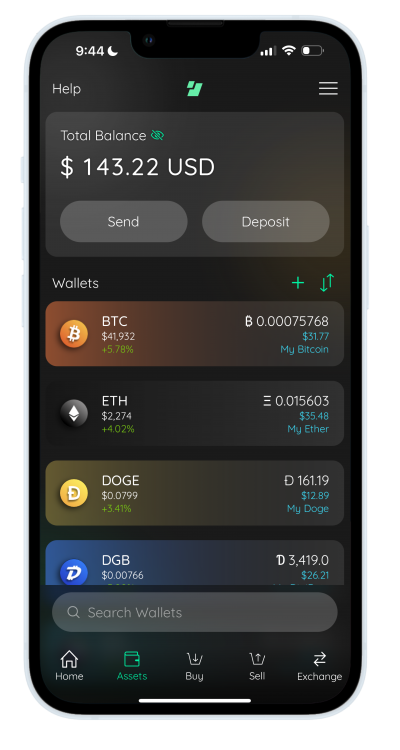SECURE
Automatic client-side encryption ensures bitcoin keys are always encrypted and protected from malware.
PRIVATE
HD address rotation, decentralized access, & zero-knowledge encryption make Edge the #1 most private cross-platform account.
DECENTRALIZED
Connectivity to multiple public bitcoin nodes ensures wallets function even if Edge servers are down.
POWERFUL
Transaction tagging and multiple wallets per account make the power users happy.
INTUITIVE
The familiarity of a username & password hides the complexity of cryptography and synchronization.
EXPANDABLE
Edge Login, plugins, and the Edge SDK connect the mobile wallet to a suite of other blockchain applications.
SECURE
Automatic client-side encryption ensures bitcoin keys are always encrypted and protected from malware.
PRIVATE
HD address rotation, decentralized access, & zero-knowledge encryption make Edge the #1 most private cross-platform account.
DECENTRALIZED
Connectivity to multiple public bitcoin nodes ensures wallets function even if Edge servers are down.
POWERFUL
Transaction tagging and multiple wallets per account make the power users happy.
INTUITIVE
The familiarity of a username & password hides the complexity of cryptography and synchronization.
EXPANDABLE
Edge Login, plugins, and the Edge SDK connect the mobile wallet to a suite of other blockchain applications.
Incredibly rich functionality and features.
Multi-device synchronization across all mobile devices
One-Touch 2-Factor Authentication
Simple password recovery
Multiple wallets per account with simple user defined wallet names
Integration with address book to auto-complete payee name and photo
Hierarchical Deterministic wallets with changing addresses per transaction
Support for over 140 currency exchange rates
Zero-access to user funds or transaction data by Edge or other 3rd parties
Configurable mining fees per transaction
Decentralized server architecture. Wallets work even if Edge servers are down
Open-source code. Available on Github

About Edge XRP Wallet
Edge offers users a safe and dependable way to store their XRP, along with other digital assets. By and large, users do not have to change accounts to store multiple cryptocurrencies; instead, users can simply hold a multitude of assets all inside of Edge. With security as our foundation, users can be sure that their funds are safe with Edge. The Edge XRP wallet is safe, simple, and intuitive.
SECURE
Automatic client-side encryption ensures that your private keys are always encrypted and protected from malware.
PRIVATE
Decentralized access & zero-knowledge encryption make Edge the #1 most private cross-platform account.
DECENTRALIZED
Connectivity to multiple public blockchain nodes ensures wallets function even if Edge servers are down.
POWERFUL
Transaction tagging and multiple wallets per account make the power users happy.
INTUITIVE
The familiarity of a username & password hides the complexity of cryptography and synchronization.
EXPANDABLE
Edge Login, plugins, and the Edge SDK connect the mobile wallet to a suite of other blockchain applications.
Incredibly rich functionality and features.
01
Multi-device synchronization across all mobile devices
02
One-Touch 2-Factor Authentication
03
Simple password recovery
04
Multiple wallets per account with simple user defined wallet names
05
Integration with address book to auto-complete payee name and photo
06
Hierarchical Deterministic wallets with changing addresses per transaction
07
Support for over 140 currency exchange rates
08
Zero-access to user funds or transaction data by Edge or other 3rd parties
09
Configurable mining fees per transaction
10
Decentralized server architecture. Wallets work even if Edge servers are down
11
Open-source code. Available on Github.
The Edge XRP Wallet
User controlled, private, and secure
Shows full transaction history of XRP
Support for XRP Network Destination Tags
Easily exchange between XRP and many other crypto-assets right within the wallet
Buy & sell XRP in select regions
Highly Secure
Edge includes robust security features never previously seen in a mobile, web-based, or desktop cryptocurrency wallet. Click here to learn more about Edge’s security features.
Support Network Destination Tags
Destination tags are XRP payment properties that are used to identify the beneficiary or destination of a payment. Edge supports the ability to add destination tags when sending XRP transactions.
Buy & Sell XRP In Select Regions
XRP is among the most highly traded assets on international crypto exchanges and is one of the largest global digital currencies by market valuation. Edge users can buy, sell, and trade XRP all inside of Edge without ever having to leave the app.
Why Use Edge to Purchase XRP, Bitcoin, and other Crypto?
Edge is a secure, easy, and private way to use, store, trade, and exchange crypto-assets. Many solutions either leave the responsibility of security completely on yourself, or require you to give up control and privacy. At Edge, we make sure you’re always in control of your money and information while also providing the tools necessary to protect yourself from us, others, and your own mistakes.
Edge has rich functionality, a battle-tested security architecture, and the industry’s best customer support. You’re never alone but always independent with Edge.
Multi-Currency Support
Unlike many other mobile wallets, Edge supports multiple cryptocurrencies beyond Bitcoin. We are continuously developing and striving to add full support for additional currencies.
Intuitive User Interface
Because our user interface was created with user-friendliness as a top priority, it is quite simple to use. A user can create and access several wallets via the Wallets screen, view balances, and manage their cryptocurrency portfolio simply and straightforwardly. In addition, we offer sophisticated security settings which are isolated from the rest of the app and can only be accessed by entering the full password for the account.
Beautifully Designed
Edge’s color configuration is carefully considered and pleasing to the eye. Furthermore, the design is straightforward and clear, resulting in a simplified user experience.
Multi-Purpose
Customers can send and receive digital currencies in their wallet and exchange cryptocurrencies on the go. With these exchange features, crypto investors can move when the markets do.
If you think a digital asset is about to fall, trade it for another asset that will rise or hold its value. The exchange feature is an innovative and easy way for users to manage their portfolios.
Mobile
A mobile cryptocurrency wallet allows you to access your coins anywhere throughout the day and provides hardened security against threats like malware, which are more prevalent on desktop applications.
